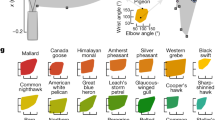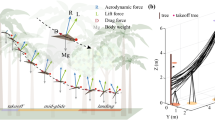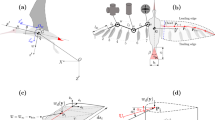Abstract
Gliding birds continually change the shape and size of their wings1,2,3,4,5,6, presumably to exploit the profound effect of wing morphology on aerodynamic performance7,8,9. That birds should adjust wing sweep to suit glide speed has been predicted qualitatively by analytical glide models2,10, which extrapolated the wing’s performance envelope from aerodynamic theory. Here we describe the aerodynamic and structural performance of actual swift wings, as measured in a wind tunnel, and on this basis build a semi-empirical glide model. By measuring inside and outside swifts’ behavioural envelope, we show that choosing the most suitable sweep can halve sink speed or triple turning rate. Extended wings are superior for slow glides and turns; swept wings are superior for fast glides and turns. This superiority is due to better aerodynamic performance—with the exception of fast turns. Swept wings are less effective at generating lift while turning at high speeds, but can bear the extreme loads. Finally, our glide model predicts that cost-effective gliding occurs at speeds of 8–10 m s-1, whereas agility-related figures of merit peak at 15–25 m s-1. In fact, swifts spend the night (‘roost’) in flight at 8–10 m s-1 (ref. 11), thus our model can explain this choice for a resting behaviour11,12. Morphing not only adjusts birds’ wing performance to the task at hand, but could also control the flight of future aircraft7.
This is a preview of subscription content, access via your institution
Access options
Subscribe to this journal
Receive 51 print issues and online access
$199.00 per year
only $3.90 per issue
Buy this article
- Purchase on Springer Link
- Instant access to full article PDF
Prices may be subject to local taxes which are calculated during checkout





Similar content being viewed by others
References
Rosén, M. & Hedenström, A. Gliding flight in a jackdaw. J. Exp. Biol. 204, 1153–1166 (2001)
Tucker, V. A. Gliding birds: the effect of variable wing span. J. Exp. Biol. 133, 33–58 (1987)
Pennycuick, C. J. Gliding flight of the fulmar petrel. J. Exp. Biol. 37, 330–338 (1960)
Newman, B. G. Soaring and gliding flight of the black vulture. J. Exp. Biol. 35, 280–285 (1958)
Pennycuick, C. J. Wind-tunnel study of gliding flight in the pigeon Columba livia. J. Exp. Biol. 49, 509–526 (1968)
Müller, U. K. & Lentink, D. Turning on a dime. Science 306, 1899–1900 (2004)
Weiss, P. Wings of change: shape-shifting aircraft ply future skyways. Sci. News 164, 359 (2003)
Rayner, J. M. V. in Current Ornithology Vol. 5 (ed. Johnston, R. F.) 1–66 (Plenum, New York, 1988)
Hoerner, S. F. & Borst, H. V. Fluid-dynamic Lift (Hoerner, Bakersfield, California, 1985)
Azuma, A. The Biokinetics of Flying and Swimming 2nd edn (AIAA Education Series, Reston, Virginia, 2006)
Bäckman, J. & Alerstam, T. Confronting the winds: orientation and flight behaviour of roosting swifts, Apus apus. Proc. R. Soc. Lond. B 268, 1081–1087 (2001)
Bruderer, B. & Weitnauer, E. Radarbeobachtungen über Zug und Nachtflüge des Mauerseglers (Apus apus). Rev. Suisse Zool. 79, 1190–1200 (1972)
Parrott, G. C. Aerodynamics of gliding flight of a black vulture Coragyps atratus. J. Exp. Biol. 53, 363–374 (1970)
Nachtigall, W. Der Taubenflügel in Gleitflugstellung: geometrische Kenngrössen der Flügelprofile und Luftkrafterzeugung. J. Ornithol. 120, 30–40 (1979)
Withers, P. C. An aerodynamic analysis of bird wings as fixed aerofoils. J. Exp. Biol. 90, 143–162 (1981)
Thomas, A. L. R. The flight of birds that have wings and tails: variable geometry expands the envelope of flight performance. J. Theor. Biol. 183, 237–245 (1996)
Tucker, V. A. & Parrott, G. C. Aerodynamics of gliding flight in a falcon and other birds. J. Exp. Biol. 52, 345–367 (1970)
Bäckman, J. & Alerstam, T. Harmonic oscillatory orientation relative to the wind in nocturnal roosting flights of the swift Apus apus. J. Exp. Biol. 205, 905–910 (2002)
Lack, D. Swifts in a Tower (Methuen, London, 1956)
Pennycuick, C. J. Flight of auks (Alcidae) and other Northern sea birds compared with Southern Procellariiformes: ornithodolite observations. J. Exp. Biol. 128, 335–347 (1987)
Ruijgrok, G. J. J. Elements of Airplane Performance (Delft Univ. Press, Delft, 1994)
Vogel, S. Life in Moving Fluids 2nd edn (Princeton Univ. Press, Princeton, 1994)
Schmitz, F. W. Aerodynamik des Flugmodells (C.J.E. Volckmann, Berlin, 1942)
Schlichting, H. Boundary Layer Theory 7th edn (McGraw-Hill, New York, 1979)
Videler, J. J., Stamhuis, E. J. & Povel, G. D. E. Leading-edge vortex lifts swifts. Science 306, 1960–1962 (2004)
Hedenström, A. & Rosén, M. Predator versus prey: on aerial hunting and escape strategies in birds. Behav. Ecol. 12, 150–156 (2001)
Veldhuis, L. L. M. Configuration and Propulsion Aerodynamics Research in the Low Speed Aerodynamics Laboratory [in Dutch] (Internal Report LSW 93–1, Faculty of Aerospace Engineering, Delft University of Technology, Delft, 1993)
Bird, J. D. Tuft-Grid Surveys at Low Speeds for Delta Wings (Technical Note D-5045, NASA, Hampton, Virginia, 1969)
Pennycuick, C. J., Alerstam, T. & Hedenström, A. A new low-turbulence windtunnel for bird flight experiments at Lund University, Sweden. J. Exp. Biol. 200, 1441–1449 (1997)
Glutz von Blozheim, U. N. & Bauer, K. M. Handbuch der Vögel Mitteleuropas (Akademischer, Wiesbaden, 1980)
Acknowledgements
Swifts were supplied by Vogelopvang Woudenberg, Fugelpits Moddergat, Fugelhelling Ureterp, Vogelopvang De Strandloper Bergen, Vogelasiel De Wulp Den Haag, Vogelasiel Haarlem, Vogelasiel Naarden and Vogelopvang Someren. Swift photographs were provided by J.-F. Cornuet (front-view, Fig. 1a) and L.G.M. Schols (side-view Fig. 1a; Fig. 1b). N.G. Verhagen, J. Bäckman and J.H. Becking helped with background research. E.W. Karruppannan, L.J.G.M. Bongers, L. Molenwijk, L.M.M. Boermans, S. Bernardy and H. Schipper helped with the experimental set-up. F.T. Muijres and R. Petie helped with the experiments. T.P. Weber and S.M. Deban critically read the manuscript. O. Berg improved many versions of the manuscript. U.K.M. is funded by NWO, and A.H. by Carl Trygger’s Foundation.
Author information
Authors and Affiliations
Corresponding author
Ethics declarations
Competing interests
Reprints and permissions information is available at www.nature.com/reprints. The authors declare no competing financial interests.
Supplementary information
Supplementary Information
This file contains Supplementary Figures 1-2 with Legends, Supplementary Table 1, Supplementary Equations , full protocol and additional references. (PDF 2016 kb)
Rights and permissions
About this article
Cite this article
Lentink, D., Müller, U., Stamhuis, E. et al. How swifts control their glide performance with morphing wings. Nature 446, 1082–1085 (2007). https://doi.org/10.1038/nature05733
Received:
Accepted:
Issue Date:
DOI: https://doi.org/10.1038/nature05733
This article is cited by
-
Morphological evolution of bird wings follows a mechanical sensitivity gradient determined by the aerodynamics of flapping flight
Nature Communications (2023)
-
Unveiling the Mechanism Behind the Asymmetric Bending Compliance of Thin-Walled U-Shaped Strips: A Study Inspired by Plant Leaves
Acta Mechanica Solida Sinica (2023)
-
Predicting the Maximum Dry Density of Soil by Using the Individual and Hybrid Framework of the Decision Tree
Indian Geotechnical Journal (2023)
-
From the eye to the wing: neural circuits for transforming optic flow into motor output in avian flight
Journal of Comparative Physiology A (2023)
-
Birds can transition between stable and unstable states via wing morphing
Nature (2022)
Comments
By submitting a comment you agree to abide by our Terms and Community Guidelines. If you find something abusive or that does not comply with our terms or guidelines please flag it as inappropriate.



